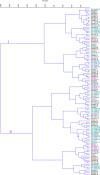Selection of superior genotypes of Indian jujube (Ziziphus mauritiana Lamk.) as revealed by fruit-related traits
- PMID: 35311171
- PMCID: PMC8907730
- DOI: 10.1002/fsn3.2721
Selection of superior genotypes of Indian jujube (Ziziphus mauritiana Lamk.) as revealed by fruit-related traits
Abstract
The nutritional and medicinal benefits of Ziziphus mauritiana Lamk. have led to its attention. Here, morphological and pomological diversity of this species was investigated. Most of the characters recorded showed considerable differences among the genotypes studied. The range of ripening data was from mid-February to mid-March. Fruit weight ranged between 15.68 and 33.62 g with an average of 24.17. Strong diversity was observed among the genotypes in terms of fruit skin ground color, ranging from light green to orange. There were significant correlations between some characters especially between the traits related to fruit size. Principal component analysis (PCA) classified the traits into 12 main components, justifying 75.07% of the total variance. The studied genotypes were grouped into two main clusters, indicating strong diversity among them. The present information might be used to choose the genotypes with the desired traits. Twenty-one genotypes were promising because of high values of fruit weight, fruit taste, fruit skin color, and fruit quality, and thus, they can be recommended for direct cultivation and also to be used in breeding programs. The genotypes with superior traits can be further used for improvement through selection and hybridization to get desired traits.
Keywords: gene pool; morphological variation; quality; skin color; superior genotype.
© 2022 The Authors. Food Science & Nutrition published by Wiley Periodicals LLC.
Conflict of interest statement
The authors declare no conflict of interest.
Figures




Similar articles
-
Identification of the promising mango (Mangifera indica L.) genotypes based on morphological and pomological characters.Food Sci Nutr. 2022 Jul 18;10(11):3638-3650. doi: 10.1002/fsn3.2961. eCollection 2022 Nov. Food Sci Nutr. 2022. PMID: 36348779 Free PMC article.
-
Identification of superior jujube (Ziziphus jujuba Mill.) genotypes based on morphological and fruit characterizations.Food Sci Nutr. 2021 Apr 5;9(6):3165-3176. doi: 10.1002/fsn3.2276. eCollection 2021 Jun. Food Sci Nutr. 2021. PMID: 34136181 Free PMC article.
-
Selection of the promising fig (Ficus carica L.) accessions using fruit-related characters.Food Sci Nutr. 2022 Apr 15;10(9):2911-2921. doi: 10.1002/fsn3.2886. eCollection 2022 Sep. Food Sci Nutr. 2022. PMID: 36171776 Free PMC article.
-
Morphological and pomological characterizations of pomegranate (Punica granatum L.) to select superior genotypes.Sci Rep. 2025 Feb 27;15(1):7038. doi: 10.1038/s41598-025-91595-8. Sci Rep. 2025. PMID: 40016411 Free PMC article.
-
The jujube (Ziziphus jujuba Mill.) fruit: a review of current knowledge of fruit composition and health benefits.J Agric Food Chem. 2013 Apr 10;61(14):3351-63. doi: 10.1021/jf4007032. Epub 2013 Mar 28. J Agric Food Chem. 2013. PMID: 23480594 Review.
Cited by
-
Genotypic variations of Tamarix aphylla (L.) H.Karst. population for heavy metal phytoremediation: a case study in Markazi province, Iran.BMC Plant Biol. 2025 Jul 11;25(1):898. doi: 10.1186/s12870-025-06940-w. BMC Plant Biol. 2025. PMID: 40646459 Free PMC article.
-
Morphological and chemical characterizations of jujube (Ziziphus jujuba Mill.) to select superior accessions.Food Sci Nutr. 2022 Mar 21;10(7):2213-2223. doi: 10.1002/fsn3.2831. eCollection 2022 Jul. Food Sci Nutr. 2022. PMID: 35844916 Free PMC article.
-
Morphological characterization and interspecific variation among five species of Ziziphus genus to select superiors in Iran.BMC Plant Biol. 2023 Nov 8;23(1):550. doi: 10.1186/s12870-023-04566-4. BMC Plant Biol. 2023. PMID: 37936089 Free PMC article.
-
Association between quantitative morphological traits and RAPD molecular markers in pomegranate (Punica granatum L.).Food Sci Nutr. 2023 Oct 8;12(1):105-115. doi: 10.1002/fsn3.3744. eCollection 2024 Jan. Food Sci Nutr. 2023. PMID: 38268899 Free PMC article.
-
Assessment of Fruit Traits and Antioxidant Capacity in Wild and Cultivated Genotypes of Ziziphus sp.Plants (Basel). 2025 Jan 5;14(1):134. doi: 10.3390/plants14010134. Plants (Basel). 2025. PMID: 39795394 Free PMC article.
References
-
- Ashraf, A. , Sarfraz, R. A. , Anwar, F. , Shaukat Ali Shahid, S. A. , & Alkharfy, K. M. (2015). Chemical composition and biological activities of leaves of Ziziphus mauritiana L. native to Pakistan. Pakistan Journal of Botany, 47(1), 367–376.
-
- Aulakh, P. S. , Mehotra, N. K. , & Vij, V. K. (2000). Performance of ber varieties grown under rainfed conditions in Punjab. Indian Journal of Horticulture, 57(2), 123–124.
-
- Awasthi, O. P. , More, T. A. , & Liu, M. J. (2009). Genetic diversity and status of Ziziphus in India. Acta Horticulture, 840, 33–40. 10.17660/ActaHortic.2009.840.2 - DOI
-
- Bhatia, A. , & Mishra, T. (2009). Free radical scavenging and antioxidant potential of Ziziphus mauritiana (Lamk.) seed extract. Journal of Complementary Integrative Medicine, 8, 42–46.
-
- Dahiru, D. , & Obidoa, O. (2007). Pretreatment of albino rats with aqueous leaf extract of Ziziphus mauritiana protects against alcohol induced liver damage. Tropical Journal of Pharmaceutical Research, 6, 705–710.
LinkOut - more resources
Full Text Sources

